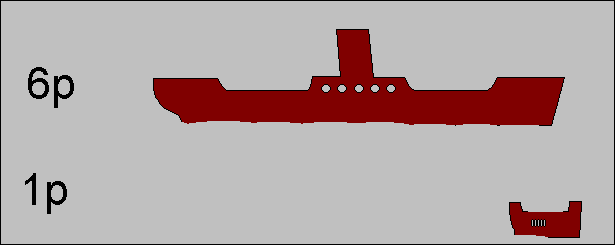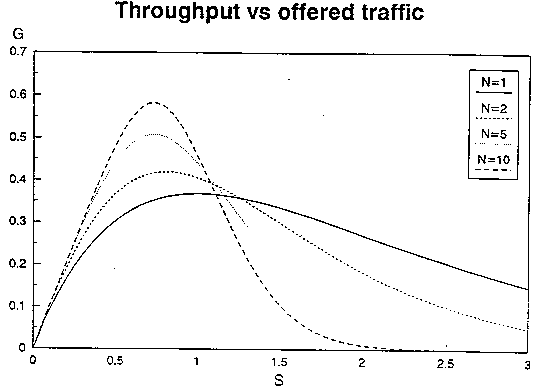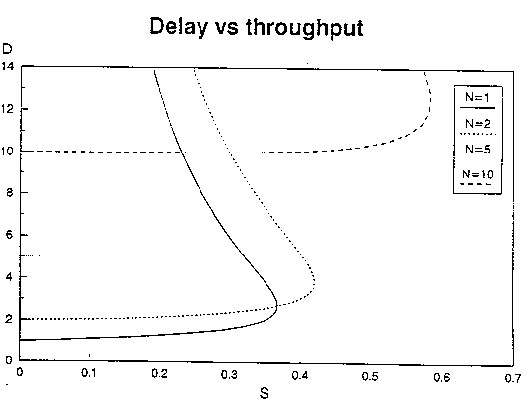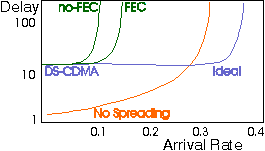
 | JPL's Wireless Communication Reference WebsiteChapter: Data Networks |
Although bandspreading with perfectly orthogonal signals may theoretically enhance system capacity, it does not resolve the instability of ALOHA random access unless special measures are taken to control retransmission traffic. Using a Stack Algorithm at small traffic loads, the packet delay is minimized if no spreading is applied. At large traffic loads, perfect CDMA enhances performance, but for imperfect signal separation at the receiver, advantages of CDMA are lost. Typically the capacity of the Stack Algorithm can be enhanced from 0.32 to at least 0.40 if a large spreading factor with perfect signal separation is employed.

| Intuitive explanation of the effect of CDMA in a random access network, by making an analogon with randomly arriving boat passengers. |
In a lightly loaded network, the packet delay increases if one applies spread spectrum transmission. This is explained by the fact that without intentional spreading, messages can have very short duration, which substantially reduces the transmission time. On the other hand, at large traffic loads, spreading may enhance performance, provided that near-perfect detection methods are used. Presumably interference-cancellation techniques and multi-signal detection are needed to reliably separate up to C signals in a CDMA system with spreading factor C.
To some extent, these observations disagree with favorable results for CDMA cellular telephony systems. In circuit-switched telephony the main performance criterion is a guaranteed maximum outage probability for the entire duration of a call. The 'averaging' the effect of interference over time and bandwidth may then favorably affect the probability that the interference occasionally is too large. In efficient packet-switched networks however, the interference can be fairly large for a substantial portion of time without excessively affecting the average performance. In such networks, capture probabilities benefit if the interference power level fluctuates from slot to slot. Moreover, the delay penalty from longer packet transmission times due to spreading appears to be significant.
For a system without spreading and modulation compactness of r bit/s/Hz, the packet duration TL is TL = L / (r Bc). The system is slotted, i.e., the time axis is divided into slots and any packet transmission starts at the beginning of a slot and finishes at the end of the same slot. Ignoring propagation delays and power-up (guard) times, we assume that the slot time is identical to TL.
We compare this system with CDMA transmission
with spreading factor C . For a fair comparison we maintain the same total
system bandwidth, irrespective of the spreading factor considered.
This implies that the slot duration and packet transmission
time are proportional to
C so these become equal to TL = C L / (r BC). The message
arrival rate, expressed in packets per time slot becomes ![]() TL =
TL =
![]() C L / (r Bc).
We normalize the
unit of time taking L / (r Bc) = 1, i.e., one unit of time equals the slot duration
in a system with C =1.
C L / (r Bc).
We normalize the
unit of time taking L / (r Bc) = 1, i.e., one unit of time equals the slot duration
in a system with C =1.
C-1 (CG)^k
S = G exp(-CG) Sum ------
k=0 k!
where S denotes the expected number of successful packets per slot and G
denotes the number of attempted transmissions per slot. For C = 1, this reduces to the throughput of slotted ALOHA without capture: S = G exp(-G). Increasing C adds more terms, so it enhance the throughput.

Throughput improves with increasing spread factors: S tends to G
(S goes to C ![]() , G goes to C
, G goes to C ![]() )
for
)
for ![]() less than unity and C goes to infinity.
less than unity and C goes to infinity.
If one uses retransmission probability p, and assumes a steady-state stable network, the delay d can be expressed as
TL G exp(-CG)
d = --- ----------------
p C-1 (CG)^k
Sum ------
k=0 k!

This suggests that with increasing C, the ALOHA random access system 'looses' its contention character and its properties become closer to that of a fixed assignment scheme.
| Spread Factor | Perfect CDMA | Imperfect CDMA | ||
| t = 0 | t = 2 | |||
|
| | |||
| C = 1 | 0.32 | 0.32 | 0.32 | |
| C = 2 | 0.34 | 0.16 | 0.18 | |
| C = 5 | 0.37 | 0.13 | 0.17 | |
| C = 10 | 0.40 | 0.12 | 0.15 | |
| C = 15 | 0.40 | 0.11 | 0.15 | |
| C = 20 | 0.40 | 0.10 | 0.14 | |
Efficient collision resolution algorithms have been proposed, such as the Stack Algorithm. For this system the network is stable, even if the number of terminals in infinite. Hence, for the stack algorithm one can compute delays, whereas rigid computations show that the delay in infinite-user ALOHA nets is unbounded.

|
Figure: Delay for stack random-access scheme, normalized to
slot duration of system without spreading.
Arrival rate in packets per time slot, for a system without spreading. Signal to noise ratio (Eb/N0) = 100 (20 dB). Packet length 256 bits. Orange: no spreading. Violet, Green: CDMA with 10 dB spreading gain: perfect signal separation; without error correction; and with two-error correcting code. |
The curves show that C = 1 gives a significantly smaller
delay than a larger spreading factor. For large ![]() , however, spreading gives
better performance.
, however, spreading gives
better performance.
Even if
CDMA allows perfect capture, for l
< 0.3 the delay is minimized if C = 1.